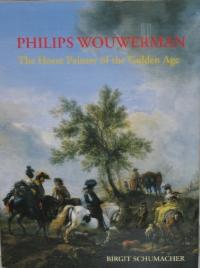A Fashion Painter and the Art World of His Time
 We look at seventeenth-century pictures from a
We look at seventeenth-century pictures from aremote perspective. We bring to them our own
conceptions of what a painting should achieve, and
our notions arise from our own experiences,
education and cultural background or, perhaps,
merely from our conception of that background.
Wouwerman's contemporaries saw pictures
differently than we do. They discovered in them
reflections of their world. Wouwerman's art is
therefore only incompletely to be understood in
formalistic terms, i.e., with reference to formal
influence from models or colleagues. To understand
the contribution of exterior factors to concrete
pictorial invention, these must be examined and
interpreted against the background of
contemporary culture and taste. (...)
Production for an open art market
Every artist who worked for the open art market had to take the domestic situation of his fellow burghers into consideration when creating pictures. Wouwerman painted the greater majority of his works for this open market. Thus, in the early stage of his career, he primarily created pictures of small or medium-large format with unpretentious subjects and restrained colours, with only touches of strong local colour. These intimate works could comfortably share space with other picture in the narrow houses. With their detailed rendering, numerous anecdotal events, and humoristic scenes, they were consummate cabinet paintings, which their owners could handle and inspect closely.
Wouwerman soon developed a variety of subjects, not specializing in any one genre. With only about seven or eight hundred collecting households and enormous competition for their patronage, Haarlem market was presumably quickly saturated. To capture the attention of potential buyers and to cultivate consumer loyalty, Wouwerman almost constantly had new themes on offer. (...)
Wouwerman rendered some subjects only once or a few times, as with the seascapes, as if he wished to test what might or might not catch on with the public. At the same time his pictures never became nondescript in the sense that they were not somehow typical for him. The compositions of his many subjects tend to resemble each other because of the frequent repetition of a few basic schemes. In addition to his trademark of the white horse, and horses in general, these recurring patterns guaranteed a high degree of recognizability. (...)
Few of Wouwerman's early pictures are therefore prestigious showpieces. This changed in the late forties, and it makes sense to seek the impetus behind this development in the artist's social circumstances. Around this time the configuration of collections evolved due to the mentioned increasing spatial segregation in Haarlem homes. Small and colouristically reserved subjects were still, but less, in demand; in addition, large and prestigious works were required to affirm the social status of the owner in his reception room or rooms. We may presume that Wouwerman observed this development. (...)
Excerpt from Capitel 4